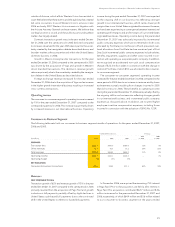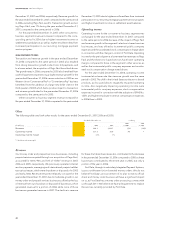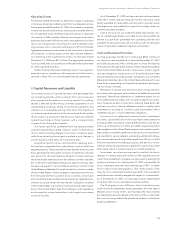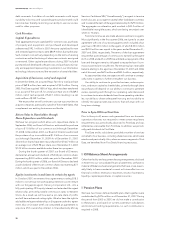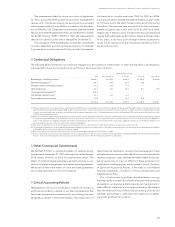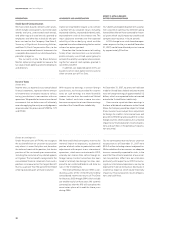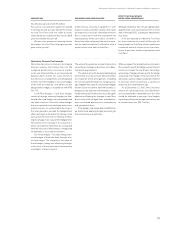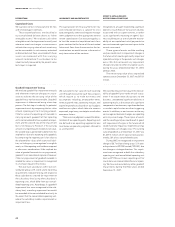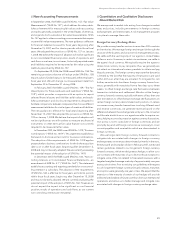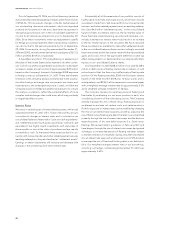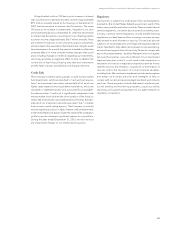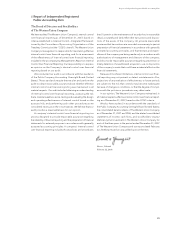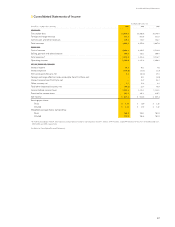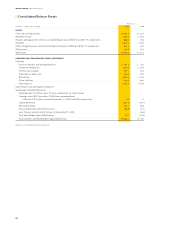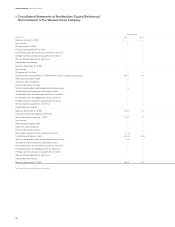Western Union 2007 Annual Report Download - page 42
Download and view the complete annual report
Please find page 42 of the 2007 Western Union annual report below. You can navigate through the pages in the report by either clicking on the pages listed below, or by using the keyword search tool below to find specific information within the annual report.
40
WESTERN UNION 2007 Annual Report
DESCRIPTION
Capitalized Costs
We capitalize certain initial payments for new
and renewed agent contracts.
These capitalized costs are classifi ed in
our consolidated balance sheets as “other
intangible assets”. We evaluate such other
intangible assets for impairment annually and
whenever events or changes in circumstances
indicate the carrying value of such assets may
not be recoverable. In such reviews, estimated
undiscounted cash fl ows associated with these
as sets are compared with their carrying
amounts to determine if a write-down to fair
value (normally measured by the present value
technique) is required.
Goodwill Impairment Testing
We evaluate goodwill for impairment annually
and whenever events or changes in circum-
stances indicate the carrying value of the
goodwill may not be recoverable. Goodwill
impair ment is determined using a two-step
process. The fi rst step is to identify if a potential
impairment exists by comparing the fair value
of each reporting unit to its carrying amount.
If the fair value of a reporting unit exceeds its
carrying amount, goodwill of that reporting
unit is not considered to have a potential impair-
ment and the second step of the impairment
test is not necessary. However, if the carrying
amount of a reporting unit exceeds its fair value,
the second step is performed to determine the
implied fair value of a reporting unit’s goodwill,
by comparing the reporting unit’s fair value to
the allocated fair values of all assets and liabili-
ties, including any unrecognized intangible
assets, as if the reporting unit had been acquired
in a business combination. If the implied fair
value of goodwill exceeds its carrying amount,
goodwill is not considered impaired. However,
if the carrying amount of goodwill exceeds its
implied fair value, an impairment is recognized
in an amount equal to that excess.
We also have subsidiaries within our con-
solidated group with stand-alone reporting
requirements. Goodwill testing with respect to
these subsidiaries is tested for impairment at
the subsidiary level using that subsidiary’s
reporting units, which differ from our consoli-
dated reporting units. Accordingly, if a goodwill
impairment loss were recognized at the sub-
sidiary level, a resulting impairment loss would
be recorded at the consolidated level only to
the extent that the consolidated reporting unit,
where the subsidiary resides, experienced an
impairment loss.
JUDGMENTS AND UNCERTAINTIES
The capitalization of initial payments for new
and renewed contracts is subject to strict
accounting policy criteria and requires manage-
ment judgment as to the appropriate time to
initiate capitalization. Our accounting policy is
to limit the amount of capitalized costs for a
given contract to the lesser of the estimated
future cash fl ows from the contract or the ter-
mination fees we would receive in the event of
early termination of the contract.
We calculate the fair value of each reporting
unit through discounted cash fl ow analyses
which require us to make estimates and
assumptions including, among other items,
revenue growth rates, operating margins, and
capital expenditures based on our budgets
and business plans which take into account
expected, regulatory, marketplace and other
economic factors.
There are also judgments around the deter-
mination of our reporting units. Reporting units
are defi ned as an operating segment or one
level below an operating segment, referred to
as a component.
EFFECT IF ACTUAL RESULTS
DIFFER FROM ASSUMPTIONS
Disruptions to an agent relationship, signifi cant
declines in cash fl ows or transaction volumes
associated with an agent contract, or other
issues signifi cantly impacting an agent’s busi-
ness could require us to evaluate the recover-
ability of our capitalized initial payments for
new and renewed agent contracts prior to the
annual assessment.
These types of events and the resulting
analyses could result in impairment charges in
the future which could signifi cantly impact our
reported earnings in the periods such charges
occur. We did not record any impairment
charges related to other intangible assets
during the years ended December 31, 2007,
2006 or 2005.
The net carrying value of our capitalized
contract costs at December 31, 2007 was $193.1
million.
We could be required to evaluate the recover-
ability of goodwill prior to the annual assess-
ment if we experience disruptions to the
business, unexpected signifi cant declines in
operating results, a divestiture of a signifi cant
component of our business, signifi cant declines
in market capitalization or other triggering
events. In addition, as our business or the way
we manage our business changes, our reporting
units may also change. These types of events
and the resulting analyses could result in good-
will impairment charges in the future which
could materially impact our reported earnings
in the periods such charges occur. The carrying
value of goodwill as of December 31, 2007 was
$1,639.5 million which represented approxi-
mately 28% of our consolidated assets.
During 2005, we recognized an impairment
charge of $8.7 million relating to our 51% own-
ership interest in EPOSS Limited (“EPOSS”) due
to a change in strategic direction. This impair-
ment was recognized at both the subsidiary
reporting unit and consolidated reporting unit
level as EPOSS was its own reporting unit for
stand-alone and consolidated fi nancial report-
ing. We have not recorded any other goodwill
impairments during the three years ended
December 31, 2007.



